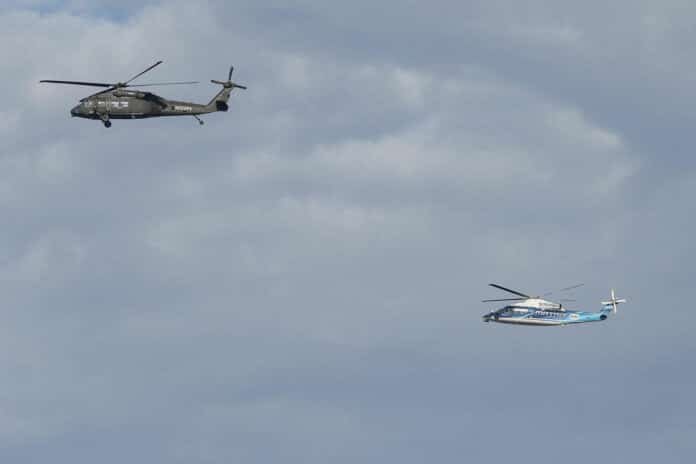A pair of research helicopters from the manufacturer Sikorsky, a Lockheed Martin company, performed a series of autonomous test flights over Long Island Sound, Connecticut, in late October. Sikorsky’s experimental helicopters, an olive-green Black Hawk OPV and a vibrant blue-and-white SARA S-76B used NASA’s cutting-edge navigation software to avoid collisions with other aircraft in the area around them.
The two ordinary-looking helicopters dance through the clouds, avoiding virtual aircraft, part of a simulation to test pilotless flight systems. This was the first time that two autonomous aircraft flew towards each other using NASA‘s collision avoidance software.
The test flights were part of a collaboration by NASA, Sikorsky, and DARPA (Defense Advanced Research Projects Agency). The goal was to gather data that would advance completely autonomous flight – systems that can operate an aircraft without a pilot from takeoff to touchdown. This is part of NASA’s research on new technologies that could eventually lead to air taxis and other new, automated air transportation options.
The research involved two experimental helicopters, Sikorsky’s SARA S-76B and the larger OPV Black Hawk, adapted for autonomous systems. The team installed five NASA-designed software systems into the helicopters, which worked with the automated flight system already integrated by Sikorsky and DARPA. These helicopters underwent rigorous tests, showcasing the potential for increased automation over time.
“These flight tests using Sikorsky’s SARA and OPV helicopters show how we can stack technologies together to increase automation over time in a maintainable and scalable way,” says Adam Yingling, NASA project lead. “These efforts demonstrate that we can safely integrate operations to fly the aircraft using several technologies in one navigation tablet.”
A NASA and a Sikorsky safety pilot onboard each helicopter supervised the flight tests, ensuring everything ran smoothly. Sikorsky’s flight autonomy system, in conjunction with NASA software, allowed the helicopters to fly autonomously along multiple planned routes. The use of tablets designed by NASA also enabled the safety pilots to monitor flight path options the software selected whenever course corrections needed to occur. NASA researchers evaluated how the different software systems worked together to control each aircraft.
The autonomous helicopters flew 12 successful flights, covering 70 different flight test maneuvers and generating more than 30 flight hours for each aircraft. During the flights, the NASA research pilots used specially designed glasses to understand how they interacted with the navigation tablets and how they physiologically responded to the information provided. The user experience data collected will be used to assist in future visual and interactive designs for the software and tablets.
The tests demonstrated the software’s capabilities in a mixed-reality setting. The SARA and OPV helicopters flew over Long Island Sound while virtual aircraft were added into the same airspace.
The NASA-designed software commanded both helicopters simultaneously, allowing research pilots and engineers to plan interactions with the virtual aircraft’s flight plans. The software systems aboard the helicopters worked together to make adjustments to avoid collisions or maintain orbital patterns for landing by changing altitude, speed, and direction.
“For this test, we are using a model of future Advanced Air Mobility airspace with more than 150 virtual aircraft and their flight plans integrated with the flight path management software and the Sikorsky mission manager technology to fly the two helicopters in a mixed-reality mode,” said Mark Ballin, principal investigator for flight path management system development.
This collaboration between NASA, Sikorsky, and DARPA is expected to usher in a new era of autonomy in aviation that could potentially save lives, aircraft, and resources.
